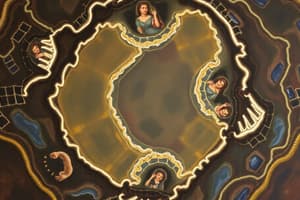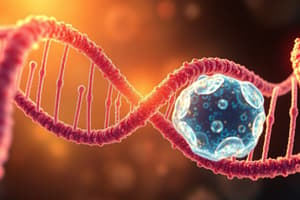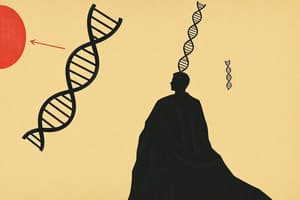Podcast
Questions and Answers
What is the relationship between the DNA content found in a skin cell and ovum? Give
an explanation for this difference.
What is the relationship between the DNA content found in a skin cell and ovum? Give an explanation for this difference.
DNA content in ovum is half that of a skin cell
Ovum is a gamete that is haploid/ contains only half the number of chromosomes
Skin cells are diploid so would contain double the DNA
The process of meiosis is involved in the production of gametes. What are the two forms of gametogenesis called and explain how they differ in the number of gametes they produce.
The process of meiosis is involved in the production of gametes. What are the two forms of gametogenesis called and explain how they differ in the number of gametes they produce.
Spermatogenesis, produces 4 sperm cells, Oogenesis, one egg cell is produced along with 3 polar bodies
(d) Sperm production occurs within the testes. Name the structure in which this process
takes place and give an advantage of this structure being tightly coiled.
(d) Sperm production occurs within the testes. Name the structure in which this process takes place and give an advantage of this structure being tightly coiled.
Seminiferous tubules Increases area for sperm production
State two structural differences between a sperm and an egg and for each difference
explain how it helps in the process of reproduction.
State two structural differences between a sperm and an egg and for each difference explain how it helps in the process of reproduction.
Explain the importance of fertilisation in sexual reproduction.
Explain the importance of fertilisation in sexual reproduction.
Most assisted reproductive technologies require the woman to take a fertility drug. Often these drugs contain follicle-stimulating hormone. Using your knowledge of the ovarian cycle in females explain what the purpose of this hormone would be in treating infertility.
Most assisted reproductive technologies require the woman to take a fertility drug. Often these drugs contain follicle-stimulating hormone. Using your knowledge of the ovarian cycle in females explain what the purpose of this hormone would be in treating infertility.
explain role of hCG in pregnancy
explain role of hCG in pregnancy
Describe how the foetal blood system is kept separate from that of the mother.
Describe how the foetal blood system is kept separate from that of the mother.
Totipotent? where?
Totipotent? where?
multipotent? where?
multipotent? where?
pluripotent? where?
pluripotent? where?
Many vital organs of a foetus are not required to function whilst it is carried in the uterus. After birth, however, rapid changes need to occur within the foetal circulation to enable the baby to survive outside the womb. Outline two major changes (besides the hole in the heart closing), that will occur.
Many vital organs of a foetus are not required to function whilst it is carried in the uterus. After birth, however, rapid changes need to occur within the foetal circulation to enable the baby to survive outside the womb. Outline two major changes (besides the hole in the heart closing), that will occur.
Occasionally a baby is born with a serious condition of the heart. There are separate abnormalities within the heart that occur as a result of this condition including that the aorta comes primarily out of the right ventricle instead of the left and the muscular wall between the right and left sides of the heart is incomplete, so the blood in the left and right ventricles is not kept separate. In a baby with the condition described above, is the hole between the ventricles an advantage or a disadvantage? Explain your choice.
Occasionally a baby is born with a serious condition of the heart. There are separate abnormalities within the heart that occur as a result of this condition including that the aorta comes primarily out of the right ventricle instead of the left and the muscular wall between the right and left sides of the heart is incomplete, so the blood in the left and right ventricles is not kept separate. In a baby with the condition described above, is the hole between the ventricles an advantage or a disadvantage? Explain your choice.
how does progesterone affect uterine lining during monthly cycle
how does progesterone affect uterine lining during monthly cycle
how does oestrogen affect uterine lining during monthly cycle
how does oestrogen affect uterine lining during monthly cycle
how does fertilisation of an egg alter the hormonal regulation of menstrual cycle?
how does fertilisation of an egg alter the hormonal regulation of menstrual cycle?
About 1 in 6 couples in Australia wanting to have children experience difficulties in
getting pregnant. Advancements in reproductive technology have resulted in a range of treatments for infertility being made available. One such assisted reproductive
technology is GIFT.
What does GIFT stand for?
About 1 in 6 couples in Australia wanting to have children experience difficulties in getting pregnant. Advancements in reproductive technology have resulted in a range of treatments for infertility being made available. One such assisted reproductive technology is GIFT.
What does GIFT stand for?
describe how gamete intra fallopian transfer takes place
describe how gamete intra fallopian transfer takes place
define stem cell
define stem cell
differences between adult and embryonic stem cells
differences between adult and embryonic stem cells
explain functions of placenta during pregnancy
explain functions of placenta during pregnancy
how do contraceptive oral pills work to prevent pregnancy
how do contraceptive oral pills work to prevent pregnancy
how to condoms work to prevent pregnancy
how to condoms work to prevent pregnancy
advantages of pills
advantages of pills
condom advantages
condom advantages
pill disadvantages
pill disadvantages
condom disadvantages
condom disadvantages
describe the changes involved from the formation of the zygote to its implantation in the uterine wall of the mother.
describe the changes involved from the formation of the zygote to its implantation in the uterine wall of the mother.
what does endoderm give rise to
what does endoderm give rise to
what does mesoderm give rise to
what does mesoderm give rise to
what does ectoderm differentiate into
what does ectoderm differentiate into
identify environmental factors that can affect the development of the fetus. use examples to illustrate how the environmental factor stated can affect development of foetus.
identify environmental factors that can affect the development of the fetus. use examples to illustrate how the environmental factor stated can affect development of foetus.
how does raw meats/fish impact development of fetus
how does raw meats/fish impact development of fetus
whats thalidamide and how does it affect foetus
whats thalidamide and how does it affect foetus
chromosonal analysis technique performed on fetus to detect genetic condition caused by non-disjunction: amniocentesis. how it works, risks involved, limitations, and what other disorders can be detected thru this technique
chromosonal analysis technique performed on fetus to detect genetic condition caused by non-disjunction: amniocentesis. how it works, risks involved, limitations, and what other disorders can be detected thru this technique
chorionic villus sampling. how it works, risks, limitations
chorionic villus sampling. how it works, risks, limitations
how fetal blood sampling works, risks associated, genetic disorders can detect, limitations
how fetal blood sampling works, risks associated, genetic disorders can detect, limitations
the dominant hormone controlling the secretory phase of the menstrual cycle is...
the dominant hormone controlling the secretory phase of the menstrual cycle is...
the main hormone(s) at work in initiating labour is..
the main hormone(s) at work in initiating labour is..
In the placenta, the mother’s blood and the fetal blood flows in opposite directions. This is important because this counter current flow will
In the placenta, the mother’s blood and the fetal blood flows in opposite directions. This is important because this counter current flow will
- The use of the rhythm method as an effective use of contraception relies on
- The use of the rhythm method as an effective use of contraception relies on
whats blastulation
whats blastulation
During blastulation, which structure releases hormones that maintain the endometrium ready for implantation?
During blastulation, which structure releases hormones that maintain the endometrium ready for implantation?
what type of stem cells make up the inner cell mass/embryoblast
what type of stem cells make up the inner cell mass/embryoblast
Placental abruption is a condition where the placenta begins to come away from the wall of the womb. Describe one effect this may have on the growing foetus. (2 marks)
Placental abruption is a condition where the placenta begins to come away from the wall of the womb. Describe one effect this may have on the growing foetus. (2 marks)
Patent foramen ovale (PFO) is the name given to the incomplete closure of the hole between the two atria in the heart of newborns. Discuss the importance of the foramen ovale in foetuses and the possible implications of PFO.
Patent foramen ovale (PFO) is the name given to the incomplete closure of the hole between the two atria in the heart of newborns. Discuss the importance of the foramen ovale in foetuses and the possible implications of PFO.
describe how in-vitro fertilisation (IVF) differs from natural fertilisation and discuss the risks involved in IVF
describe how in-vitro fertilisation (IVF) differs from natural fertilisation and discuss the risks involved in IVF
Flashcards are hidden until you start studying
Study Notes
DNA Content in Skin Cell vs. Ovum
- Skin cells are diploid containing two sets of chromosomes, while ova are haploid with one set of chromosomes.
- This difference arises from meiosis, which halves the chromosome number in gametes for sexual reproduction.
Forms of Gametogenesis
- Spermatogenesis develops sperm, producing four functional gametes per cycle.
- Oogenesis develops ova, yielding only one mature ovum from each cycle, with three polar bodies that are non-functional.
Sperm Production in Testes
- Sperm production occurs in the seminiferous tubules, which are coiled structures enhancing surface area for efficient spermatogenesis.
Structural Differences in Sperm and Egg
- Sperm are motile with a flagellum, enabling them to reach and fertilize the egg.
- Eggs are larger and contain nutritive yolk, providing essential nutrients for early embryonic development.
Importance of Fertilization
- Fertilization combines genetic material from sperm and ovum, ensuring genetic diversity in offspring and initiating developmental processes.
Role of Follicle-Stimulating Hormone (FSH)
- FSH stimulates ovarian follicle maturation, promoting ovum development and aiding in the treatment of infertility by enhancing egg production.
Role of Human Chorionic Gonadotropin (hCG)
- hCG maintains the corpus luteum, ensuring continued production of progesterone, crucial for sustaining pregnancy in the early stages.
Separation of Fetal Blood System from Mother
- The placenta serves as a barrier between maternal and fetal blood, preventing direct mixing while facilitating nutrient and gas exchange.
Stem Cell Potency
- Totipotent stem cells can develop into any cell type, found in early embryos.
- Multipotent stem cells have a limited capacity, such as hematopoietic stem cells in bone marrow.
- Pluripotent stem cells can differentiate into almost any cell type, present in embryonic stem cells.
Changes in Fetal Circulation at Birth
- Closure of the ductus arteriosus redirects blood flow to the lungs.
- Closure of the foramen ovale ensures separation of oxygenated and deoxygenated blood.
Heart Condition with Ventricular Septal Defect
- The hole between ventricles could be a disadvantage, allowing unoxygenated blood to mix, impairing the baby’s oxygen supply.
Progesterone Effects on Uterine Lining
- Progesterone thickens and maintains the uterine lining, preparing it for potential implantation after ovulation.
Oestrogen Effects on Uterine Lining
- Oestrogen promotes growth and repair of the uterine lining, facilitating a suitable environment for implantation.
Hormonal Regulation Alteration Post-Fertilization
- After fertilization, hormone levels change, particularly with elevated hCG, which supports the luteal phase and prevents menstruation.
Gamete Intra-Fallopian Transfer (GIFT)
- GIFT stands for Gamete Intra-Fallopian Transfer, involving the placement of both sperm and eggs directly into the fallopian tubes for fertilization.
Stem Cell Definition
- Stem cells are undifferentiated cells capable of self-renewal and differentiation into various specialized cell types.
Differences Between Adult and Embryonic Stem Cells
- Adult stem cells are limited in differentiation and primarily serve to replace damaged cells; embryonic stem cells are pluripotent and can generate any cell type.
Functions of the Placenta During Pregnancy
- Provides nutrients and oxygen to the fetus, removes waste products, and produces hormones that support pregnancy.
Oral Contraceptive Pills
- Work by releasing hormones to inhibit ovulation, thicken cervical mucus to block sperm, and thin the uterine lining.
Condoms as Contraceptives
- Act as physical barriers to prevent sperm from entering the uterus, reducing the chance of fertilization.
Advantages of Oral Pills
- High effectiveness rate, ease of use, and can regulate menstrual cycles.
Advantages of Condoms
- Provide protection against sexually transmitted infections (STIs) and do not require a prescription.
Disadvantages of Pills
- Possible side effects include hormonal imbalances and increased risk of blood clots; requires regular intake.
Disadvantages of Condoms
- Can reduce sensitivity; potential for breakage or slippage, requiring proper use for effectiveness.
Studying That Suits You
Use AI to generate personalized quizzes and flashcards to suit your learning preferences.




